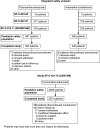Safety and efficacy of pyronaridine-artesunate paediatric granules in the treatment of uncomplicated malaria in children: insights from randomized clinical trials and a real-world study
- PMID: 38418982
- PMCID: PMC10902982
- DOI: 10.1186/s12936-024-04885-3
Safety and efficacy of pyronaridine-artesunate paediatric granules in the treatment of uncomplicated malaria in children: insights from randomized clinical trials and a real-world study
Abstract
Background: Children are particularly at risk of malaria. This analysis consolidates the clinical data for pyronaridine-artesunate (PA) paediatric granules in children from three randomized clinical trials and a real-world study (CANTAM).
Methods: An integrated safety analysis of individual patient data from three randomized clinical trials included patients with microscopically-confirmed Plasmodium falciparum, body weight ≥ 5 kg to < 20 kg, who received at least one dose of study drug (paediatric safety population). PA was administered once daily for 3 days; two trials included the comparator artemether-lumefantrine (AL). PCR-adjusted day 28 adequate clinical and parasitological response (ACPR) was evaluated. Real-world PA granules safety and effectiveness was also considered.
Results: In the integrated safety analysis, 63.9% (95% CI 60.2, 67.4; 426/667) of patients had adverse events following PA and 62.0% (95% CI 56.9, 66.9; 222/358) with AL. Vomiting was more common with PA (7.8% [95% CI 6.0, 10.1; 52/667]) than AL (3.4% [95% CI 1.9, 5.8; 12/358]), relative risk 2.3 (95% CI 1.3, 4.3; P = 0.004), occurring mainly following the first PA dose (6.7%, 45/667), without affecting re-dosing or adherence. Prolonged QT interval occurred less frequently with PA (3.1% [95% CI 2.1, 4.8; 21/667]) than AL (8.1% [95% CI 5.7, 11.4; 29/358]), relative risk 0.39 (95% CI 0.22, 0.67; P = 0.0007). In CANTAM, adverse events were reported for 17.7% (95% CI 16.3, 19.2; 460/2599) of patients, most commonly vomiting (5.4% [95% CI 4.6, 6.4; 141/2599]), mainly following the first dose, (4.5% [117/2599]), with all patients successfully re-dosed, and pyrexia (5.4% [95% CI 4.6, 6.3; 140/2599]). In the two comparative clinical trials, Day 28 ACPR in the per-protocol population for PA was 97.1% (95% CI 94.6, 98.6; 329/339) and 100% (95% CI 99.3, 100; 514/514) versus 98.8% (95% CI 95.7, 99.9; 165/167) and 98.4% (95% CI 95.5, 99.7; 188/191) for AL, respectively. In CANTAM, PA clinical effectiveness was 98.0% (95% CI 97.3, 98.5; 2273/2320).
Conclusions: Anti-malarial treatment with PA paediatric granules administered once daily for 3 days was well tolerated in children and displayed good clinical efficacy in clinical trials, with effectiveness confirmed in a real-world study. Trial registration Clinicaltrials.gov: SP-C-003-05: identifier NCT00331136; SP-C-007-07: identifier NCT0541385; SP-C-021-15: identifier NCT03201770. Pan African Clinical Trials Registry: SP-C-013-11: identifier PACTR201105000286876.
Keywords: Plasmodium falciparum; Anti-malarial; Granule formulation; Malaria; Paediatric; Pyronaridine–artesunate.
© 2024. The Author(s).
Conflict of interest statement
Stephan Duparc, Isabelle Borghini-Fuhrer and Adam Aspinall are employees of Medicines for Malaria Venture. Sarah Arbe-Barnes and Robert Miller are employees of Artemida Pharma. Jangsik Shin is an employee of Shin Poong Pharm. Co. Ltd. Naomi Richardson is an employee of Magenta Communications Ltd. which received funds from Medicines for Malaria Venture associated with this study. Martina Wibberg is an employee of DATAMAP GmbH which received funds from Medicines for Malaria Venture associated with this study. Michael Ramharter, Abdoulaye Djimde and Lawrence Fleckenstein declare no conflict of interest.
Figures






Similar articles
-
Pyronaridine-artesunate or dihydroartemisinin-piperaquine versus current first-line therapies for repeated treatment of uncomplicated malaria: a randomised, multicentre, open-label, longitudinal, controlled, phase 3b/4 trial.Lancet. 2018 Apr 7;391(10128):1378-1390. doi: 10.1016/S0140-6736(18)30291-5. Epub 2018 Mar 29. Lancet. 2018. PMID: 29606364 Free PMC article. Clinical Trial.
-
Pyronaridine-artesunate granules versus artemether-lumefantrine crushed tablets in children with Plasmodium falciparum malaria: a randomized controlled trial.Malar J. 2012 Oct 31;11:364. doi: 10.1186/1475-2875-11-364. Malar J. 2012. PMID: 23113947 Free PMC article. Clinical Trial.
-
Efficacy and safety of pyronaridine-artesunate versus artemether-lumefantrine in the treatment of acute uncomplicated malaria in children in South-West Nigeria: an open-labelled randomized controlled trial.Malar J. 2023 May 13;22(1):154. doi: 10.1186/s12936-023-04574-7. Malar J. 2023. PMID: 37179349 Free PMC article. Clinical Trial.
-
Pyronaridine-artesunate for treating uncomplicated Plasmodium falciparum malaria.Cochrane Database Syst Rev. 2019 Jan 8;1(1):CD006404. doi: 10.1002/14651858.CD006404.pub3. Cochrane Database Syst Rev. 2019. Update in: Cochrane Database Syst Rev. 2022 Jun 21;6:CD006404. doi: 10.1002/14651858.CD006404.pub4. PMID: 30620055 Free PMC article. Updated.
-
Paediatric formulations of artemisinin-based combination therapies for treating uncomplicated malaria in children.Cochrane Database Syst Rev. 2020 Dec 8;12(12):CD009568. doi: 10.1002/14651858.CD009568.pub2. Cochrane Database Syst Rev. 2020. PMID: 33289099 Free PMC article.
References
-
- WHO. World malaria report. Geneva: World Health Organization; 2023. https://www.who.int/publications/i/item/9789240086173. Accessed 12 Dec 2023.
-
- Oshagbemi OA, Lopez-Romero P, Winnips C, Csermak KR, Su G, Aubrun E. Estimated distribution of malaria cases among children in sub-Saharan Africa by specified age categories using data from the Global Burden of Diseases 2019. Malar J. 2023;22:371. doi: 10.1186/s12936-023-04811-z. - DOI - PMC - PubMed
-
- Kurth F, Belard S, Adegnika AA, Gaye O, Kremsner PG, Ramharter M. Do paediatric drug formulations of artemisinin combination therapies improve the treatment of children with malaria? A systematic review and meta-analysis. Lancet Infect Dis. 2010;10:125–132. doi: 10.1016/S1473-3099(09)70327-5. - DOI - PubMed
-
- WHO. Guidelines for malaria. Geneva: World Health Organization; 2022. https://www.who.int/publications/i/item/guidelines-for-malaria. Accessed 28 Feb 2023.
MeSH terms
Substances
Associated data
LinkOut - more resources
Full Text Sources
Medical

